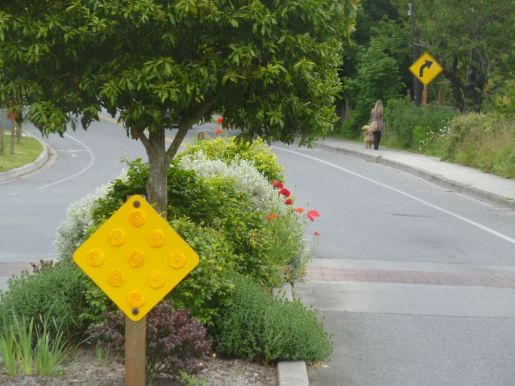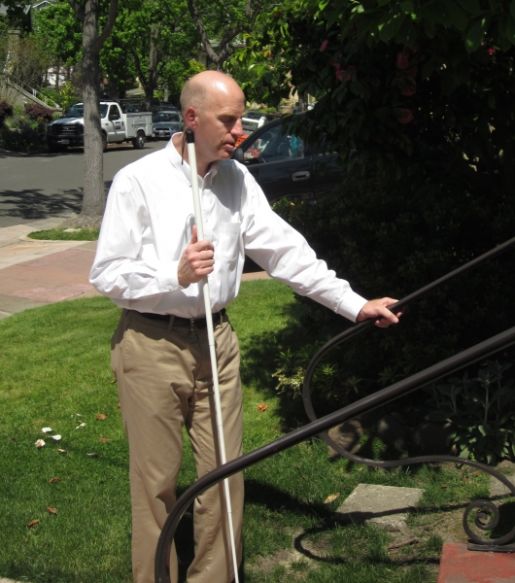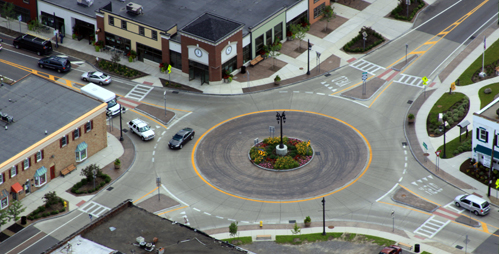You might also be interested in...
-
A course in good design
11/11/2011
-
Architect is visionary for the blind
05/16/2011
-
As you winterize your home, “futurize” it, too!
01/14/2014
-
Designed for All: Universal Design Living Laboratory, the National Demonstration Home & Garden
05/06/2013
-
Designing a university for all
03/07/2012
-
Easy living on the farm
10/28/2012
-
Existing homes can be friendlier to aging
10/08/2013
-
He made his home age-friendly
08/06/2013
-
Improving on good design to Age in Place
10/23/2013
-
Livable Communities
10/22/2013
Livable Communities
Posted: 10/22/2013
By: Monika Weiss
 Port Townsend, WA landscaped median, part of Walkable Community strategy (AFriendlyHouse.com photo)
Port Townsend, WA landscaped median, part of Walkable Community strategy (AFriendlyHouse.com photo)
Livable communities advance inclusion through purposeful design. Public spaces such as community centers, parks and universities are rethought to advance walkability, social equity and access to education. Livable communities are designed to be circulate people, not cars.
Suburban sprawl has been costly in terms of environmental impacts on traditional farmlands and pollution from automobiles, but, as New York Times Personal Health columnist Jane Brody points out, commuting from those suburbs takes a definite toll on Americans' health as well.
But the news isn't all bad, she says, as demographic shifts fuel a rethinking of how to design "healthier communities less dependent on motorized vehicles for transportation."
The town of Hamburg, NY, said no to widening a highway and gained a truly livable community. Read Dennis Gaffney's "Widen Main Street? A Village Had Other Ideas, and Then Thrived" (New York Times, Aug. 17, 2013). As Dan Burden from the Walkable Communities told Hamburg villagers "you can't bring back a village without bringing back a street."
The Stanford Healthy Neighborhood Discovery Tool is a phone app that allows people to survey their communities for livability, reports Stephanie M. Lee in The San Francisco Chronicle.
(Photo: Michael Short, Special to The San Francisco Chronicle)
Cities have an aromatic landscape, and one that can be manipulated by architects and designers, according to architect Lance Hosey, writing in The New York Times' Gray Matters column on Oct. 27, 2013.
"Smell is the most primal of our senses," Hosey writes, and we can relate, remembering the pulp mill stench of the town where we grew up, a short drive but a far cry from the coffee-scented streetscapes of today's Seattle.
Many cities are known for their scent, be it the eucalyptus of San Francisco or the sulphur of Rotura in New Zealand. Citing studies that prove the benefits of certain scents on health, Hosey asks, why shouldn't architects and designers of cities incorporate aromas to promote health and well-being?
"That the scent of a city should have a potent impact shouldn't surprise us," he writes, noting that "people tidy up more when there's a hint of citrus in the air."
Hosey may just have sniffed out "a whole new field of design."
To find out more about individual projects that promote a livable community, please see:
Redesigning a veterans golf course creates a space for healing for vets of all ages and abilities. Modifications, such as shallow sandtraps with three points of roll-in entry, seen right, allow riders to use the course as seemlessly as walkers.
Architect adapts public spaces for better use by the blind and us all 
Blind architect Chris Downey shapes designs so that they make more sense to the blind, while at the same time increasing the seamless flow for all users of public spaces. Whereas ADA requirements are generally limited to addressing our differences in mobility, Downey's tool box is filled with the senses most architects leave out like touch and sound. While his story is one of overcoming great of obstacles, his work is a lesson on how design can transform our experience of the space around us.
Designing a university for all 
There has been an historical barrier to higher education for the severely disabled. Although the Internet opens the possibility to online courses, the built environment of a college campus generally does not keep pace. On the University of Illinois Urbana Champaign campus, however, the environment of inclusion runs from its pioneering leadership in wheelchair sports programs to a supportive campus landscape, that now more importantly includes accessible dorms designed for the severely disabled.


 A course in good design
A course in good design